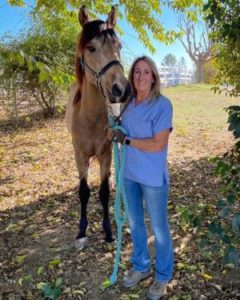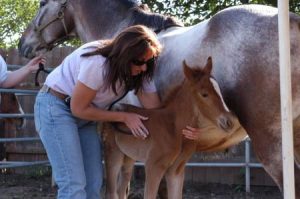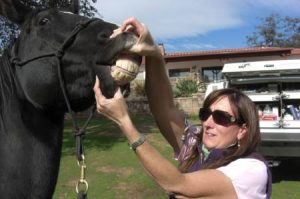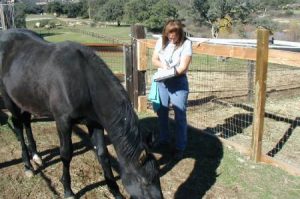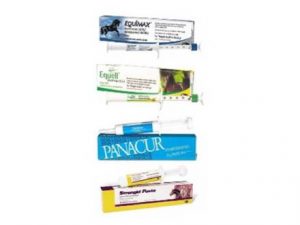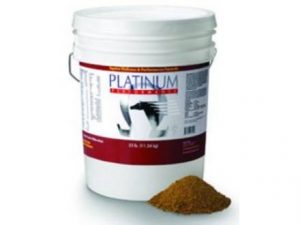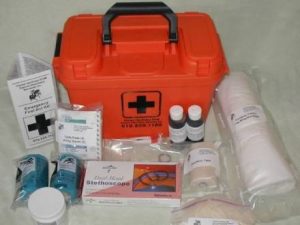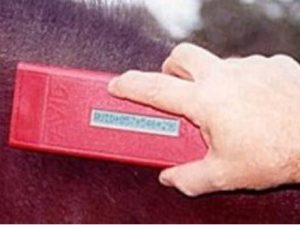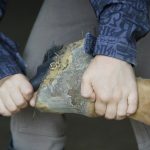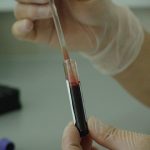Grass cracks usually occur in unbalanced and/or dry brittle feet and are predisposed by overlong hoof walls, which can lead to traumatic injury.
Sand cracks usually occur following traumatic injury to the coronary band or as a result of abnormal stress at the coronary band caused by unbalanced feet, overlong concave hoof walls or excessive and repeated concussive stress.
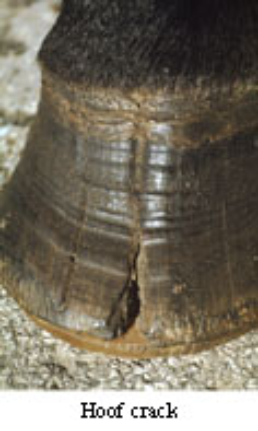
Hoof wall cracks are visibly obvious, but their significance must be determined in terms of their extent and whether or not they involve the coronary band or whether they have introduced hoof infection.
In lame horses, a crack through the coronary band may be painful to palpate and the edges may move apart when the horse bears weight, signifying instability. The pain is caused by pinching and inflammation of the sensitive hoof laminae at the edge of the crack. Alternatively, a crack through the ground surface may be associated with a localised area of pain on palpation, signifying infection and abscess formation.
In long-standing hoof cracks, radiographic (x-ray) examinations may reveal secondary pedal bone damage (see our hand out on pedal osteitis). How are hoof cracks treated?
Ground surface cracks which are not associated with lameness should be removed or stabilised by hoof wall trimming and shoeing where necessary. Where the crack is deep or extensive, further stabilisation may be achieved by shoeing with toe or quarter clips either side of the crack or, usually less successfully, by grooving a horizontal line or lines across the end of the crack, as deep as the crack.
Where there is a solar abscess, this should be located, cut out and treated (see our handout on pus in the foot) and the crack removed or stabilised by hoof wall trimming.
Where the coronary band is involved, the crack should be cut out along its length to minimise pinching of the laminae and to prevent perpetuation by overlapping edges, then stabilised using a variety of methods depending upon the nature of the crack and the experience and preference of the farrier:-
- For recent and uncomplicated cracks, stabilisation may be best achieved by wiring or lacing the crack together through horizontal holes drilled through the hoof and then further stabilised with fibreglass or acrylic patches stuck over the crack and wires or laces. The foot should then be shod with a full-bar shoe with clips.
- For long-standing and complicated cracks, the edges of the crack should be held apart by filling the crack with acrylic hoof repair material and further stabilised with fibreglass or acrylic patches stuck over the crack and wires or laces. The foot should then be shod with a full-bar shoe with clips.
Afterwards, stable rest is required until the crack is stabilised and healing. The foot should be trimmed and the stabilisation re-applied as the hoof grows (approximately 0.6 cm per month) and the crack changes position. How are hoof cracks prevented?
Horses feet should be regularly trimmed at all times and shod when necessary. Regular hoof care is necessary especially during times of dry weather.
Feed supplements containing biotin and methionine may help to aid good quality hoof growth, especially for those horses with naturally brittle feet. Those with naturally brittle feet may also benefit from being fed gelatine.
Always ask Dr. Garfinkel to see a lame horse or one with coronary band damage as many different problems may cause lameness and a precise diagnosis must be made as early as possible if the horse is to receive the correct treatment.
Infection, if present, must always be treated before attempting to stabilise a hoof crack. All horses and ponies should be vaccinated against tetanus.
Coronary band damage can often lead to unpleasant hoof complications. Long-standing, complicated cracks which involve the coronary band are often difficult to repair completely and will need constant care and supervision.
Call us at 619.659.1180 if you have any comments or questions about Hoof Cracks.

